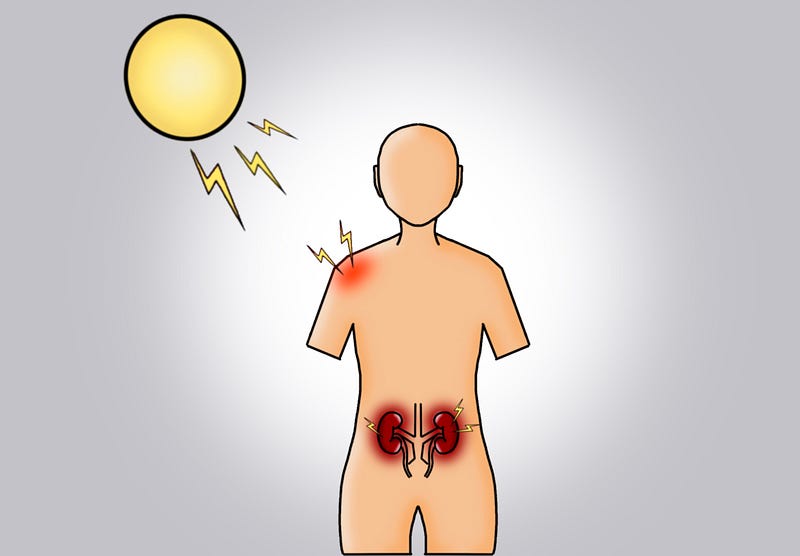Sunlight and SLE: Understanding Kidney Damage in Lupus Patients
Written on
Chapter 1: The Impact of Sunlight on SLE
For individuals with systemic lupus erythematosus (SLE), exposure to sunlight can pose significant risks. SLE is an autoimmune disorder where the immune system mistakenly attacks the body's own tissues. Unlike individuals with a healthy immune response, even limited exposure to UV radiation can provoke skin rashes in those afflicted with SLE.
However, an intriguing phenomenon arises: sunlight exposure can also lead to kidney damage—affecting nearly half of SLE patients—resulting in systemic flares. The exact mechanisms behind this occurrence remain unclear.
A pivotal study from 2021, conducted by Dr. Sladjana Skopelja-Gardner and her team at the Geisel School of Medicine at Dartmouth, explores the interplay between skin and kidney responses in SLE. The research indicates that inflammatory reactions triggered by ultraviolet (UV) light in the skin can also extend to the kidneys.

Understanding the Mechanism of UV-Induced Damage
Sunlight consists of approximately 5% UV radiation. When it contacts the skin, keratinocytes, the skin cells, absorb this UV light, which can lead to DNA damage and other cellular harm. If the damage is minor, the body can repair it; if it's severe, the cells undergo programmed death. The innate immune system then clears away the dead cells, triggering inflammation as immune cells are recruited to remove the debris. This process usually concludes without complications in healthy individuals.
In contrast, the immune response in SLE patients is notably slower, resulting in an aggressive release of inflammatory proteins that can damage surrounding tissues. This raises an essential question: since the damaged keratinocytes are found in the skin's outer layers, why does kidney damage occur when the kidneys are shielded from direct sunlight?
Dr. Skopelja-Gardner and her colleagues revealed in their paper, “Acute skin exposure to ultraviolet light triggers neutrophil-mediated kidney inflammation,” published in PNAS, that neutrophils not only migrate to the skin but also disseminate throughout the body.
The Experiment: Investigating UV Exposure Effects
To examine how UV exposure on the skin influences kidney function, researchers subjected the skin of mice to ultraviolet-B (UVB) light—the most harmful type of UV radiation. They monitored changes in the kidneys, focusing on gene expressions related to inflammation and the presence of abnormal protein levels in urine (proteinuria) for up to six days post-exposure.
Considering that no cases of light sensitivity-induced lung disease have been documented in SLE, the researchers compared kidney and lung responses following UVB exposure. Within 24 hours, they noted an increase in inflammation markers in both UVB-exposed skin and the kidneys, but not in the lungs. These inflammatory markers remained elevated until the sixth day after UV exposure, with proteinuria observed by day four.
Neutrophil Activity and Inflammation
Next, the researchers sought to determine the role of neutrophils in the inflammatory response to UVB exposure. Neutrophils are the predominant type of leukocytes (white blood cells) and are crucial first responders to both infectious and sterile inflammation.
Within 24 hours of UVB exposure, neutrophil counts surged—sevenfold in the skin, fivefold in circulating blood, and an astonishing tenfold in the kidneys compared to baseline levels. Elevated neutrophil counts were also seen in the spleen and lungs, persisting for six days. Notably, this uptick in inflammatory markers was absent when neutrophil migration was inhibited.
“Our findings suggest that neutrophils are central to the inflammatory response in the kidneys following skin UV light exposure,” the authors concluded.
Tracking Neutrophils: A Unique Discovery
Typically viewed as short-lived cells that rush to sites of inflammation, the study revealed that neutrophils can migrate back into the bloodstream and infiltrate different tissues—a phenomenon known as reverse transmigration. Utilizing genetically engineered mice that emit fluorescence upon photoactivation, the researchers tracked the neutrophils post UVB exposure.
A day after UV exposure, the area was illuminated with violet light, causing infiltrating immune cells to fluoresce. Examination of the kidneys revealed that about 4% to 7% of neutrophils present were those that had migrated from the skin. These reverse transendothelial migrated (rTEM) neutrophils exhibited high expression of the CXCR4 receptor, with none detected when non-UV exposed skin was activated.
Essentially, two types of neutrophils were identified: one that aids recovery at injury sites and another that can exacerbate tissue damage through the release of harmful substances. Given the inflammatory markers identified, the authors posited that the rTEM neutrophils likely contribute to tissue injury.
Furthermore, they discovered an increase in CXCL12 production—a protein that attracts neutrophils to the kidney during inflammation triggered by UV light exposure.
Conclusion: Implications for SLE Patients
“This research demonstrates that skin exposure to UV light can initiate inflammatory pathways relevant to lupus, with neutrophils acting as key mediators contributing to kidney damage,” explains Dr. Skopelja-Gardner.
The critical question remains: why does UV exposure lead to kidney damage in SLE patients? One explanation is that a specific subset of neutrophils first responds to UV-exposed skin before migrating to the kidneys, where they potentially inflict further harm.
The complexity of SLE makes this study significant, as it offers insights into the cellular interactions between inflamed and non-inflamed organs—an area previously unexplored that may have crucial implications for understanding and managing SLE.
Chapter 2: The Role of Neutrophils in SLE
In the video "Let's Talk Lupus: Lupus and Sun Exposure," experts discuss the risks of sun exposure for lupus patients, elaborating on the relationship between UV light and lupus symptoms.
The video "Learn about Common Lupus Symptoms" offers insights into the various symptoms that can manifest in lupus patients, including those related to sun exposure.